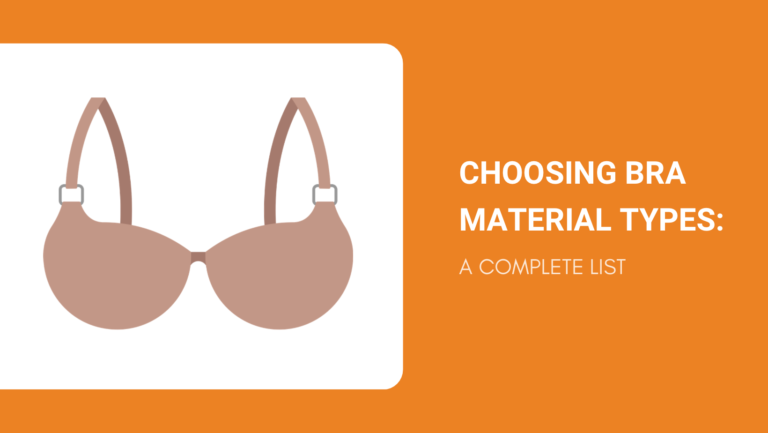As an aspiring bra business owner, one of the most important decisions you’ll make is selecting the right bra material. The fabric you choose will determine not only the comfort and support of the bra but also its durability and overall quality.
But, with so many bra fabrics available on the market, choosing the right one can be daunting. That’s why we’ve created this guide to help you navigate the different types of bra materials available and choose the best one for your needs.
We’ll provide a comprehensive list of the best bra fabrics to choose from and explore the pros and cons of each bra material. We aim to help you make an informed decision and set your bra brand up for success.
Let’s dive right in!
Best Materials for Bra Cups and Straps
The cups and straps are the main parts of a bra since they keep the breasts in place and provide protection and support. Here are the most common materials used for bra cups and straps:
Cotton
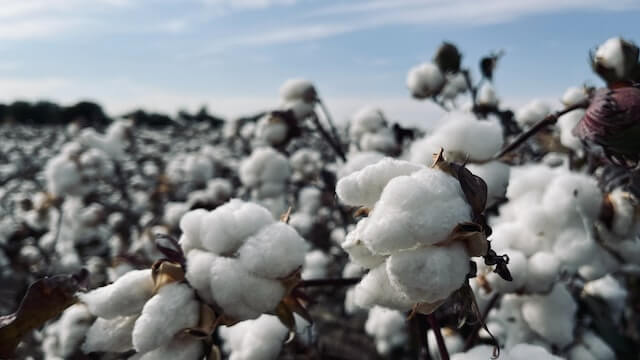
Thanks to the many advantages, most bras available on the market today are made from cotton. It’s comfortable, breathable, feels soft and natural against the skin, and is warm and absorbent.
However, cotton also has some disadvantages, such as being prone to shrinking and deforming easily, and not being as durable as some other materials.
Pros
- Great for bras made for everyday wear
- Comfortable, warm, and soft
- Breathable and absorbent
- A wide range of types, colors, and models to choose from
Cons
- Prone to shrinking and deformation over time
- Not as durable as other materials
- Not too elegant looking for high-end bras
Spandex
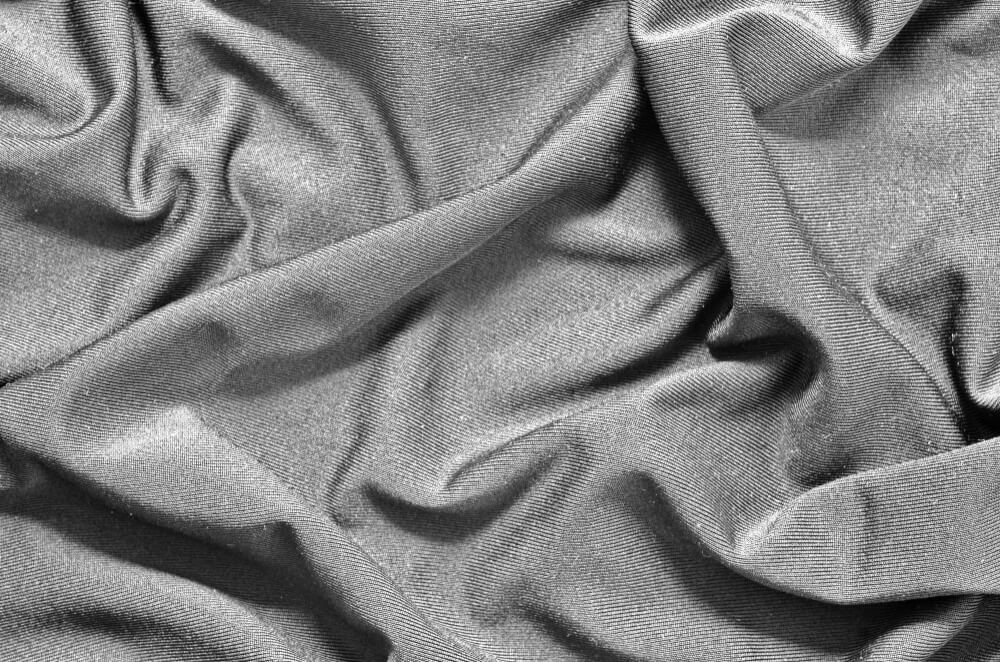
Spandex is a synthetic material commonly used in bra cups due to its elasticity. It’s a lightweight and breathable material that conforms to the body’s shape, providing comfort and support.
Additionally, spandex is quick-drying, durable, and greatly resistant to chemical or sunlight damage.
Usually, spandex is mixed with cotton, polyester, or other material when used for bras, except for sports bras, which might be purely from spandex.
Pros
- Great shape-retaining properties
- Perfect for adding elasticity to fabrics
- Commonly used for sports bras
- Provides excellent comfort and support
Cons
- Sensitive to heat
- Not as breathable as cotton
- Lack of moisture-wicking properties
Polyester (Duoplex)
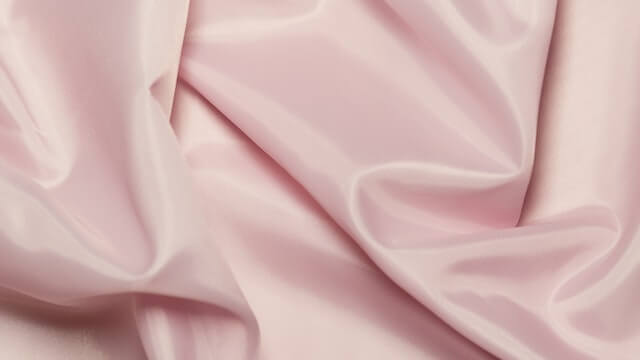
Polyester is a synthetic material frequently used for bra cups as it’s strong, durable, and lightweight.
Duoplex is one of the most commonly used types of polyester materials for bras since it has a high thread count, making it an excellent choice for producing bra cups with a smooth and polished appearance. It’s a non-stretch knit fabric that’s great for support.
Typically, duoplex is two-sided, with one shiny and one matte side, allowing you to choose either as your main one.
Pros
- Very smooth fabric and no need for lining
- Great for support and structural parts of a bra
- Strong and durable
- Double-sided (one shiny, one matte side)
Cons
- No lengthwise stretch
- Can be bulky for some types of bras
- Not a natural fabric choice as it’s 100% synthetic
Silk
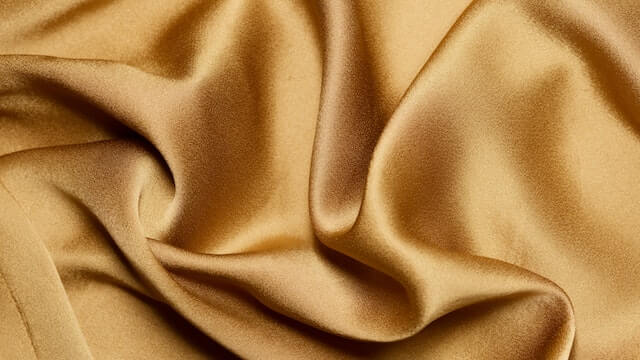
Silk is a luxurious, soft fabric commonly used in high-end lingerie and bras. It’s a breathable, lightweight, hypoallergenic material, making it ideal for individuals with sensitive skin.
On the flip side, silk requires delicate care when washing and may not be as durable as other materials.
Pros
- Soft, smooth, and gentle against the skin
- Breathable and lightweight
- Hypoallergenic
- Available in a range of colors and finishes, including matte or shiny
Cons
- Expensive compared to other bra materials
- Delicate and prone to damage
- Not suitable for bras that need stronger support
Wool
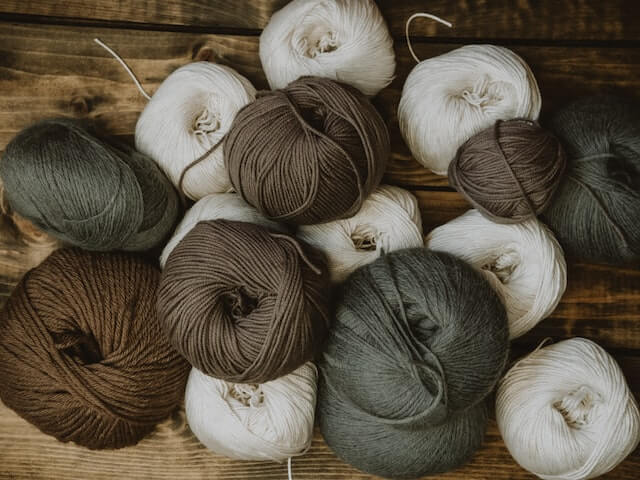
Wool is a natural fabric that’s sometimes used for high-end bras. It’s warm, soft, and moisture-wicking, making it an excellent choice for colder climates.
On its own, wool can be itchy and may not be suitable for individuals with sensitive skin. However, in luxurious bras, wool is typically mixed with other materials making it softer and providing more elasticity.
Pros
- A natural and durable material
- Great breathability and moisture-wicking properties
Cons
- More expensive than synthetic bra materials
- Requires delicate handling and maintenance
Nylon

Next, we have nylon – a synthetic fabric commonly used for bra cups. It’s lightweight, durable, affordable, and easy to care for, making it a popular choice for everyday wear.
Plus, nylon is available in various colors and patterns, so it’s usually easy to find a bra supplier for your brand.
Pros
- Affordable and durable
- Available in different styles and colors
Cons
- Looks cheaper and less stylish than other materials
- Does not absorb moisture
- It’s 100% synthetic
Modal
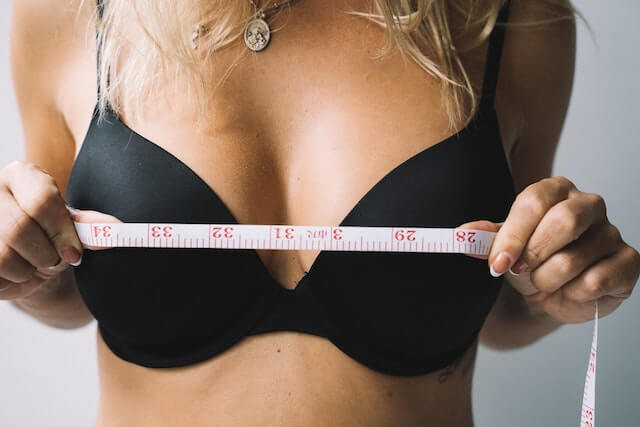
Modal is a type of rayon fabric known for its softness and draping ability, making it very comfortable to wear. On top of that, modal is breathable and moisture-wicking, which helps keep the wearer cool and dry.
Although modal is a high-end fabric, it’s often mixed with cotton or spandex to add elasticity and strength.
Pros
- Drapes nicely and doesn’t crease
- A natural and eco-friendly fabric
- Soft, durable, and breathable
- Retains its shape and doesn’t shrink
Cons
- Higher cost
- Limited color choices
- Prone to shrinkage
Elastane
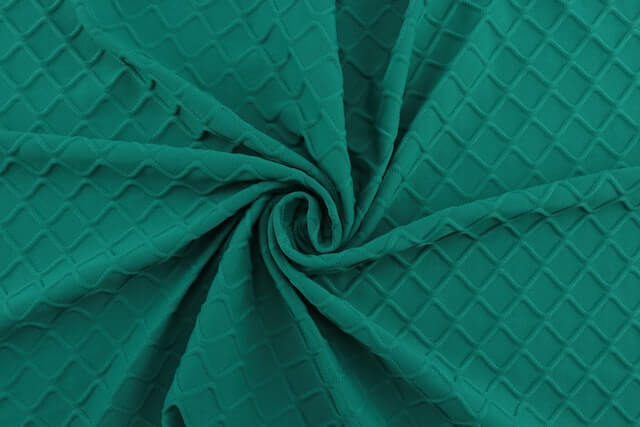
On its own, elastane is a stretchy polymer fiber used for adding stretchiness to clothing or lingerie fabrics. In most cases, when used for bras, elastane is added to another material. In this way, you get both elasticity and the support that elastane lacks.
Pros
- Excellent stretch and recovery
- Lightweight and breathable
- Resistant to shrinking and wrinkling
- Dries quickly
Cons
- Prone to damage from heat, UV rays, and chlorine
- Not as durable as nylon or polyester
- Not as supportive on its own
Satin
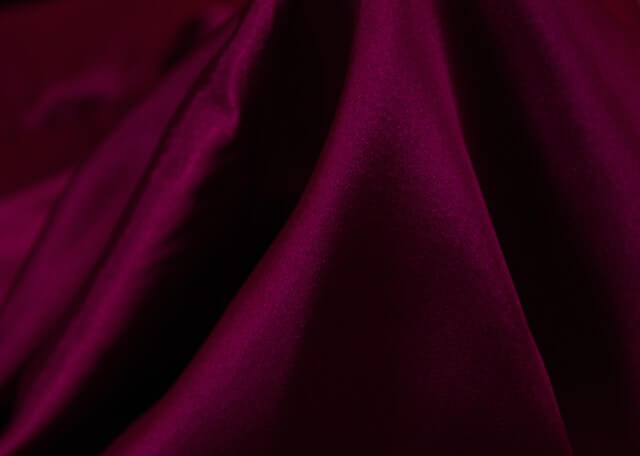
Satin is a smooth and shiny material that’s lightweight and silky, making it an excellent choice for bras and lingerie in general.
Note that you can find silk satin of better quality or synthetic satin, which tends to be too shiny and not as breathable.
Lastly, consider that satin can be delicate and may require special care when washing and drying.
Pros
- Soft, lightweight, and shiny
- A wide variety of fabric colors available
Cons
- Synthetic satins are not breathable
- Not great at moisture absorbing
Best Materials for Cup Linings
Now, let’s see the best fabrics for lining bra cups and reinforcing the front bridge of bras:
Sheer Nylon (Marquisette)
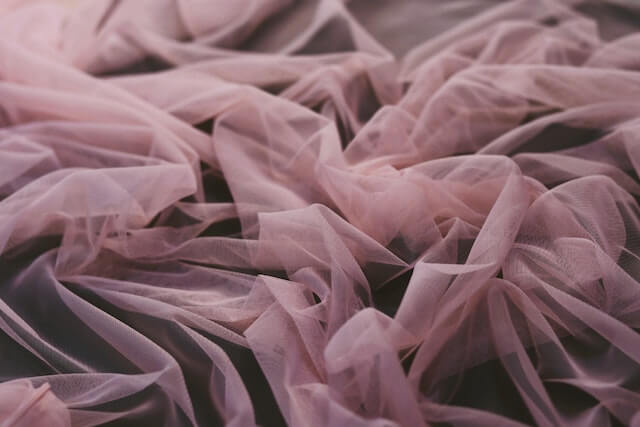
Sheer nylon is a lightweight and transparent material commonly used as a lining for bra cups. This material is known for its softness and silky texture, making it comfortable to wear for extended periods, while still providing strength due to the lack of stretch.
Lastly, sheer nylon is also breathable, allowing air to circulate and keeping you cool and dry.
Pros
- Transparent and lightweight
- Strong and supportive
- Great for structural support due to minimal stretch
Cons
- Sheer and not great for coverage
- No elasticity since it’s made of 100% nylon
Stretch Mesh
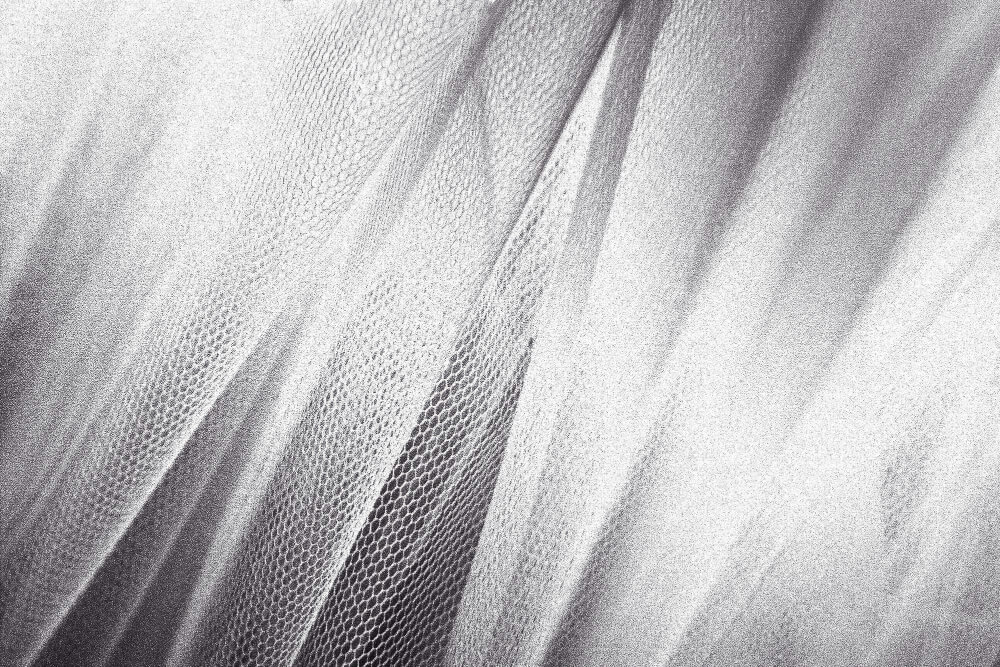
The stretch mesh fabric is typically a mix of nylon and spandex, which makes it more elastic than sheer nylon while maintaining the same transparency and invisibility.
This material has lengthwise stretch and a great level of recovery. Plus, it perfectly blends on top of any material. That’s why it’s an excellent choice for bra cup linings.
Pros
- Stretch fabric with great recovery properties
- Lightweight and sheer yet strong and durable
- Adjusts to the shape of the body
- Comes in many types and colors
Cons
- Not great for structural support since it’s stretchy
- Sheer and unsuitable for coverage
15 Denier Nylon
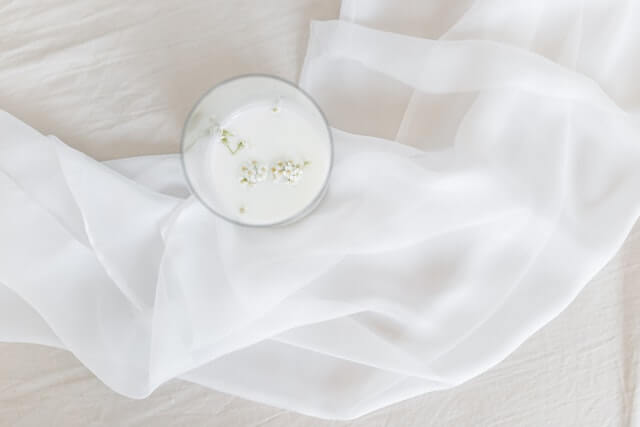
When selecting a fabric for bra cups, it’s important to consider a supportive and rigid lining material that still provides some elasticity.
15 denier nylon is an ideal choice, as it’s lightweight and sheer, yet rigid enough to provide much-needed support. This low-denier count material is made of 100% nylon, comes in various colors, and is nearly invisible.
Pros
- Mechanical cross-grain stretch
- Sheer, lightweight, and almost invisible
- Strong enough to provide support
- Available in a variety of colors
Cons
- Transparent and not suitable for coverage
- May not be as soft to the touch as other materials
- Not as breathable as other materials
Best Materials for Bra Paddings
If you’re planning to create bras that provide structure and support, you’ll need to choose fabrics for bra paddings. Here are the most commonly used ones:
Silicone
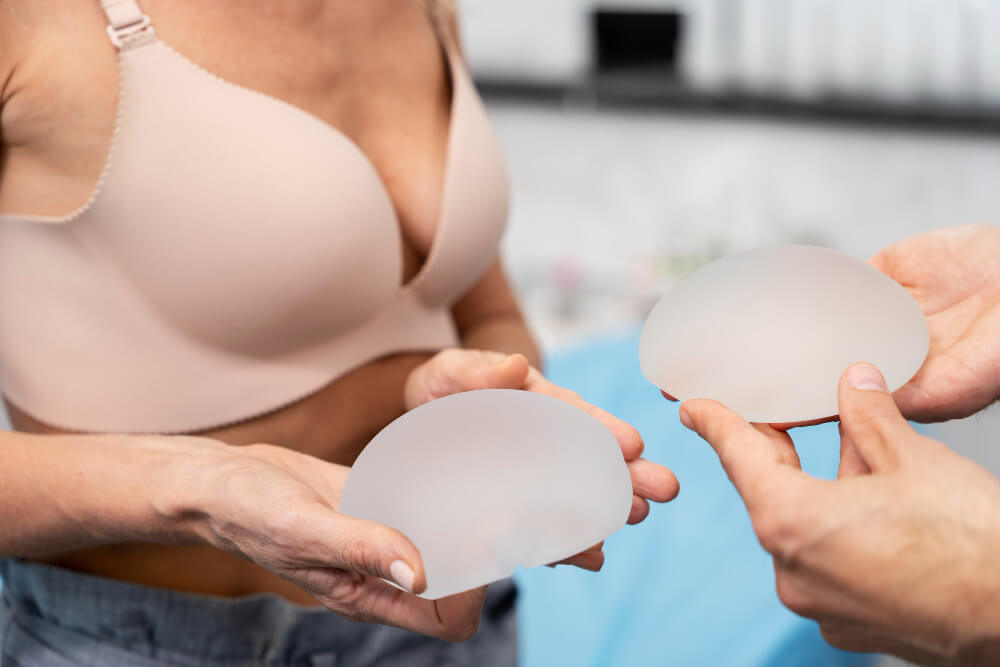
Silicone is a popular material for bra padding due to its ability to conform to the body’s shape and provide a natural look and feel. It’s hypoallergenic and easy to clean, making it convenient for many people.
However, some may find silicone heavy or uncomfortable to wear for extended periods.
Pros
- A natural look and feel of the padding
- Hypoallergenic
Cons
- Lack of breathability
- Too bulky for some bra types
Rubber

Rubber is another commonly used material for bra paddings, although it’s a cheaper option. It can provide a firm and supportive feel, but may not be as comfortable or breathable as other materials.
Pros
- Cheaper than other padding materials
Cons
- Not as common as other bra padding fabrics
- Lack of breathability
Polyurethane (PU) Foam
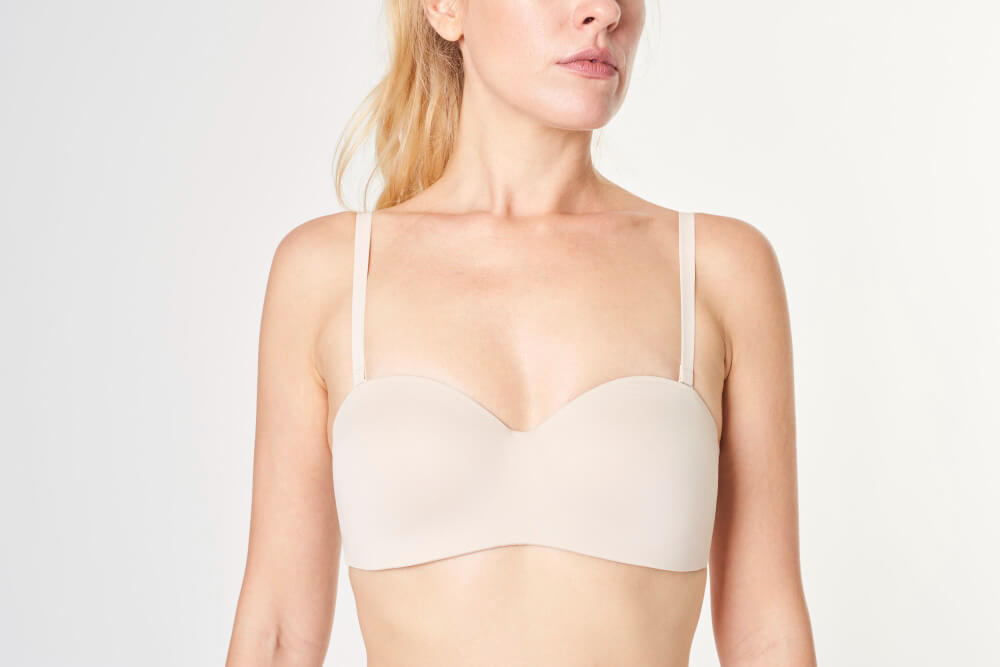
Polyurethane foam is a lightweight and versatile material commonly used for bra padding. It can provide a soft, cushioned feel and is available in a range of densities and thicknesses to suit different preferences. It’s great for getting that 3D effect.
However, PU foam may not be as durable as other materials and may compress or lose shape over time with regular wear and washing.
Pros
- Great for modeling and 3D cup effects
- A wide variety of densities and thicknesses
- Soft, cushioned, and comfortable to wear
Cons
- Could be more expensive than other padding materials
- Might lose its shape over time
Best Materials for Bra Bands (Wings)
The bands of a bra are the side pieces or wings that wrap around the rib cage and usually close at the back (some bra types close in the front). These are some fabrics you can use for this purpose:
Charmeuse
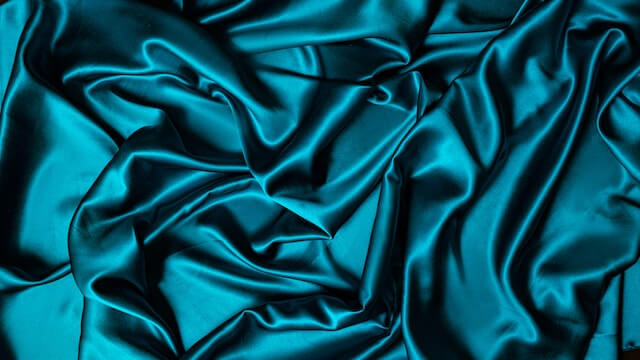
Charmeuse is one of the best woven fabrics for high-end bra bands. Traditionally, charmeuse is made of silk, although, today, you can find it also from polyester fibers.
Perhaps the best feature of charmeuse is its stiffness and stability when used for bra bands.
Pros
- Two-sided (silky and matte)
- Silky, luxurious, and comfortable feel
- Stiff enough to provide stability
Cons
- More expensive than other bra band fabrics
- Might require special care and maintenance
Plush
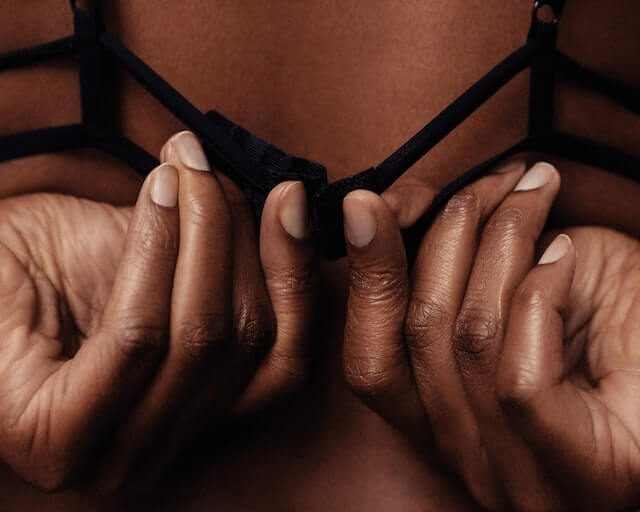
Plush elastics are typically used for bra bands since they feature a delicate picot edge suitable for use in lingerie. As an elastic fabric, plush is really soft and comfortable to wear.
This material is usually a blend of nylon and spandex, although in some instances it might contain latex.
Pros
- Soft and comfortable
- Great elasticity
Cons
- Not as commonly found as other materials
- If made with latex, it can cause skin allergies or sensitivities
Power Mesh (Power Net)

Power mesh, also known as power net, is another fabric we recommend for bra bands. It comes in different densities and degrees of stretch, including double-knit varieties.
This fabric is typically very breathable and can help keep the skin cool and dry. However, it may not be as comfortable or soft as other materials.
Pros
- Stretchy and elastic
- Breathable
- Strong and durable
Cons
- Not as soft as other band materials
- Might not be suitable for some types of bras
Best Materials for Bra Embellishment
Last but not least, let’s see what fabrics you can use to decorate and embellish your bras:
Lace
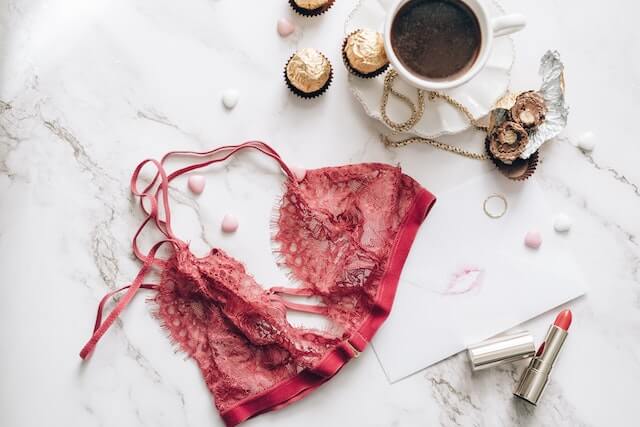
Lace is a versatile material made from various fibers, such as polyester, cotton, or rayon. It’s often used to add intricate and delicate embellishments to bras, making them more stylish and unique.
In addition to its aesthetic appeal, lace can provide a comfortable fit and improve the garment’s breathability.
Pros
- A luxurious and feminine way to embellish bras
- Breathable and lightweight
- Available in a wide range of styles and colors
Cons
- Delicate and prone to tearing
- Requires extra care and maintenance
Tulle
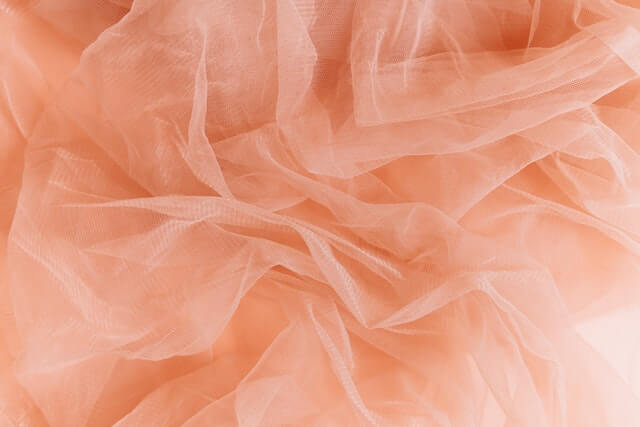
Bra tulle, unlike craft tulle, is much softer and tear-resistant. While it doesn’t offer much stretch, it has a mechanical give that’s ideal for larger sizes and cups.
This type of tulle is often used for delicate embroidered details. Lastly, its sheer quality and lightweight feel make it a breathable alternative to heavy-knit fabrics, which is why it’s frequently used in luxury lingerie.
Pros
- Soft and breathable
- Durable and tear-resistant
- Perfect for high-end lingerie
Cons
- More expensive than other embellishment materials
- Not much stretch
Jacquard
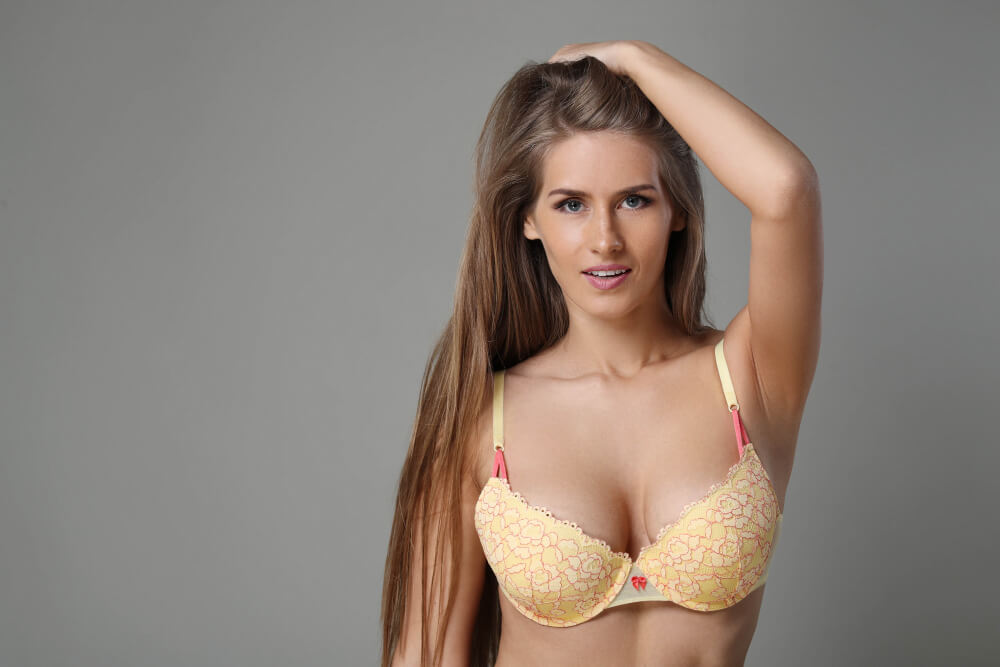
If you’re looking for astonishing bra patterns, choose jacquard. Its patterns are integrated into the weave, as opposed to being printed on the surface.
The jacquard technique is versatile and can be applied to a variety of yarn types, including cotton, silk, polyester, and acrylic fibers.
Pros
- Can be produced from different fabrics
- Many different bra patterns available
Cons
- Might be more expensive than other woven fabrics
FAQs about Bra Materials
Now, let’s review some of the most commonly asked questions on choosing the ideal bra fabric or material.
What Is the Best Material for Bras?
The best material for a bra will depend on the intended use, target group, and specific style and design. Some popular choices are cotton, microfiber, silk, or spandex, depending on the desired bra type.
All of the fabrics on our list above are suitable for different types of bras, so looking over their pros and cons should help you decide what you need.
What Material Is Used in Padded Bras?
The padding itself can be made from foam, gel, or silicone. The outer layer of the cup may be made from materials like cotton, polyester, nylon, or a combination of these.
Additionally, some padded bras use different materials for the cup lining and the outer layer, with the lining typically made of softer and more comfortable material, while the outer layer provides structure and support.
What Type of Bra Material Is the Healthiest?
The healthiest bra material is one that is comfortable, breathable, and non-irritating to the skin. Natural materials like cotton, bamboo, and silk are often considered healthier options, as they are less likely to cause skin irritation or allergic reactions than synthetic materials.
What Is the Most Breathable Fabric for Bras?
When it comes to breathability, cotton is often considered the best choice for bras. This natural material allows air to circulate, preventing sweat buildup and soaking up moisture.
Other breathable fabric options for bras include bamboo, mesh, soft lace, as well as several moisture-wicking synthetic materials.
What to Consider When Choosing a Bra Fabric?
We believe these are the most important considerations to keep in mind when choosing a bra fabric:
- Bra material: what type of bra are you designing and what’s the best material for it;
- Material properties: stretch, comfort, look, feel, weight, durability, support, and similar fabric properties;
- Quality: what’s the quality you aim for (it varies according to your budget, product, and target group);
- Target group: who is your ideal buyer and what type of product would they buy;
- Supplier availability: can you find the right supplier for the type of bra fabrics you need;
Where Can I Buy Bra Materials in Bulk?
Here are several supplier options for buying wholesale bra materials:
- Google for bulk bra material suppliers
- Check B2B marketplaces like Alibaba
- Check supplier directories
- Visit trade shows in China
- Work with a local sourcing agent in China
NicheSources is an industry-leading sourcing company in China with years of experience sourcing in different niches including bras and lingerie.
Aside from sourcing ready-to-sell bra models, we can partner with factories in China to create a private label or a brand-new product for your needs. You can choose the desired bra material, design, model, and branding of your bras and lingerie according to your specifications. Best of all? You can try our services for free by asking for a free quote.
Wrapping Up
Choosing the right material for a bra is a critical factor in creating a comfortable and supportive lingerie garment that meets your customers’ needs.
While there are many materials to choose from, each with its own advantages and drawbacks, understanding the characteristics of different fabrics can help you make an informed decision.
By prioritizing factors like breathability, durability, and comfort, you can select the best bra material for your product and create a quality garment that customers love.
